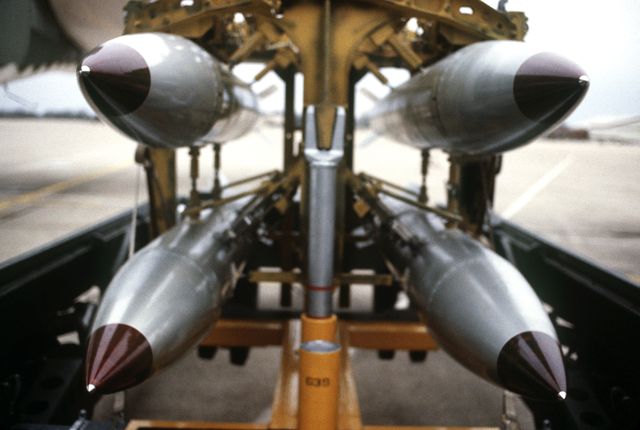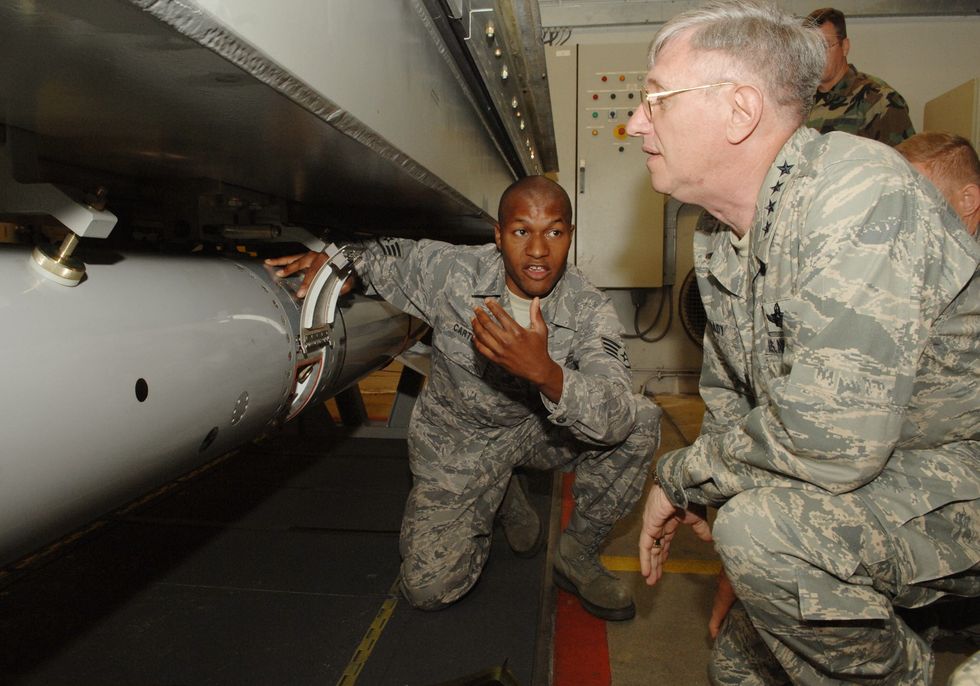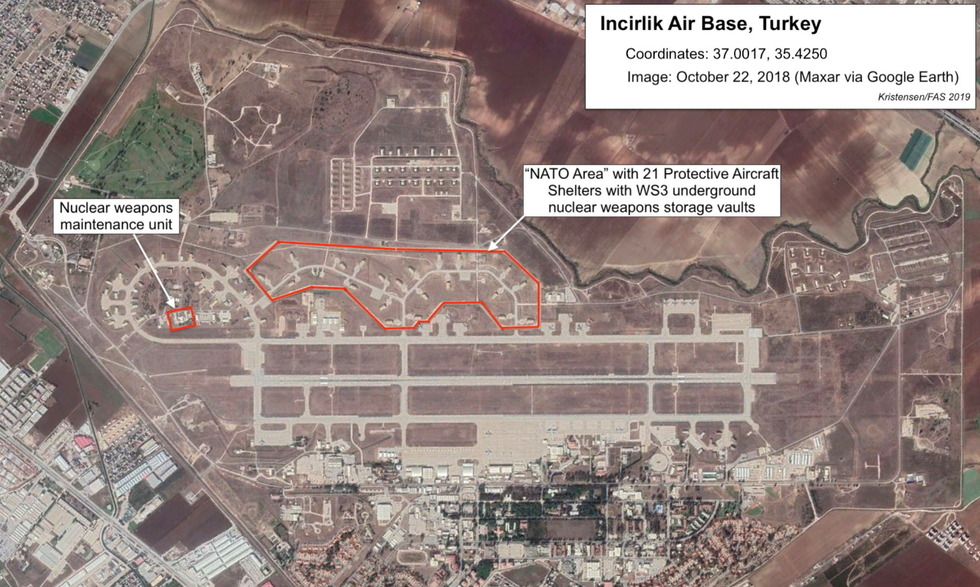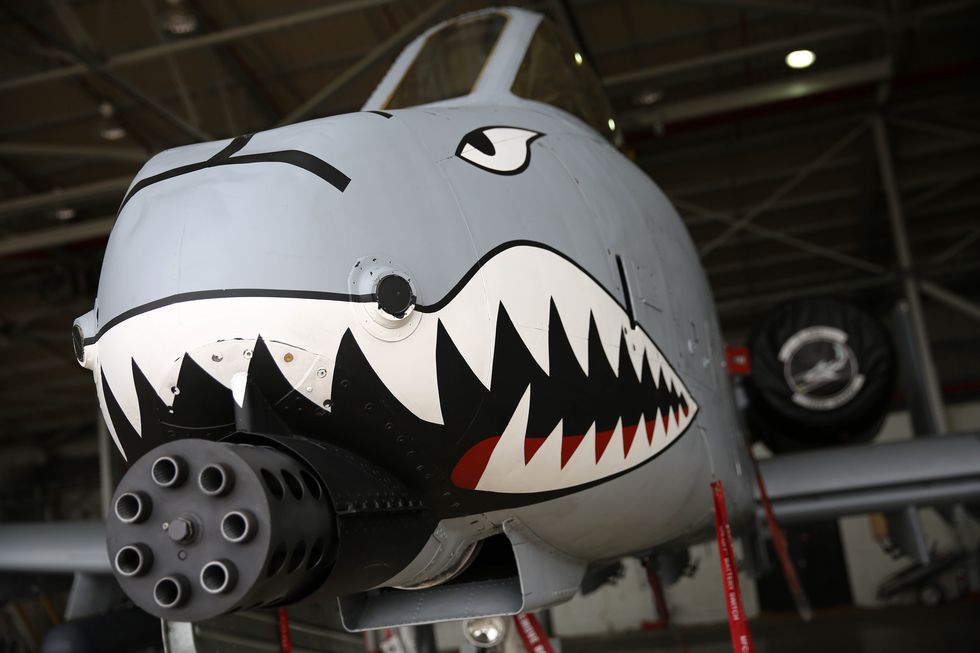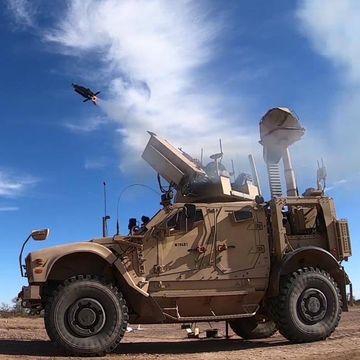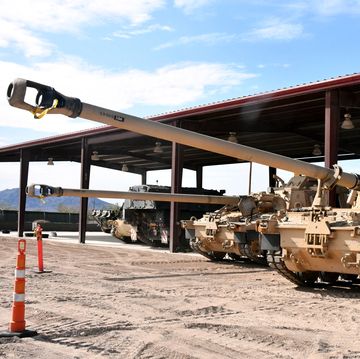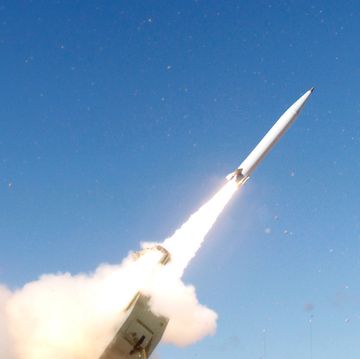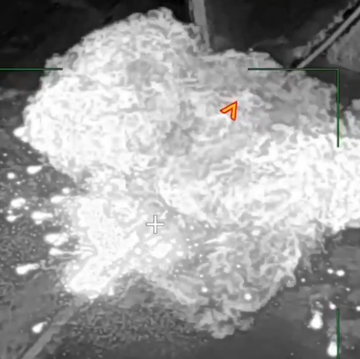The eyes of the world have become fixed on the estimated 50 B61 nuclear bombs stored at Incirlik Air Base in Turkey. As the Turkish military operations in Syria strain relations with the U.S., the security of the bombs has become a potential concern and a certain geopolitical headache. One unidentified senior U.S. official expressed worry to The New York Times that the bombs are being “held hostage” by Turkish President Recep Tayyip Erdogan.
Extreme caution is always warranted where nukes are concerned, but what is the actual risk of rogue nuclear bombs pose? How well guarded are they, and what could someone do if they got their hands on them?
Nuclear McGuffins
The first thing to consider when contemplating any heist is the loot. At the center of the stage here are B61 nuclear bombs. Designed in 1963, these have what’s known as a variable yield; set a dial on the various versions and you get a blast as small as .3 kilotons or as high as 340 kt. For some scale, the U.S. dropped a 15 kt bomb on Hiroshima.
The bombs are sleek but heavy. They are each 11 feet long, and 13 inches thick, and weigh about 700 pounds. There are 25 underground secure vaults called Weapons Security Storage Systems dug into the ground inside aircraft protective shelters. Each W3 can hold up to four of these nuclear weapons, but there are only 50 at Incirlik, according to a report this week from The New York Times and confirmed by President Donald Trump's tweets.
The location of tactical nuclear weapons in aircraft shelters is part of the Cold War legacy, when airplanes remained on alert to drop tactical nukes on any Soviet hordes advancing along its southern flank. But today, no warplanes at Incirlik these days are even capable of carrying the nukes. As the Cold War’s influence faded, there was an impulse to remove tactical nuclear weapons from Europe, including the gravity bombs kept in Turkey.
“We kind of missed the moment, I would say, about 10 years ago.,” says Sharon Squassoni, a George Washington University professor, former State Department official and member of the Science and Security Board of the Bulletin of Atomic Scientists.
“If a country like Germany had decided, ‘Yeah, let's get them all out,’ you might have had a removal of all U.S. tactical nuclear weapons, but it didn't happen,” she says. "And then, of course, you have the invasion by Russia into Crimea and Eastern Ukraine.”
Geopolitics, not strategy, kept the B61 bombs in place in Turkey. Now the situation on the ground is changing, as Turkey has defied the U.S. and pushed into Syria, attacking (now-former) U.S. allies and even bracketing U.S. advisor positions with artillery fire. To further complicate things, Incirlik is only 70 miles from the Syrian border, leading to questions over the security of the nuclear bombs.
But can you even set off a stolen nuke? It’s not easy — but that is not the only risk that a rogue nuke poses.
Strong and Weak Links
Naturally, there are many methods in place to make nukes hard to set off by accident or without authorization. But the technical details about the bombs themselves are seldom discussed, so what we know is based on public sources, some dating back decades to when these weapons were first created.
The first design principal to consider is called strong link/weak link, built into new nukes since 1975.
“Critical elements of the detonator system are deliberately ‘weak’ in that they will irreversibly fail if exposed to certain kinds of abnormal environments,” writes Columbia University’s Steven Bellovin, a cybersecurity professor at Columbia University who has collected reams of open source material on nuclear weapon protections. “A commonly-used example is a capacitor whose components will melt at reasonably low temperatures.”
An example of a “strong link” that protects the bomb is the detonation system, which is electrically separated from the rest of the bomb so that its won’t be fried by bursts of energy (like other exploding bombs or jamming.) “The strong link provides electrical isolation of the detonation system,” Bellovin writes. “It only responds to very particular inputs.”
The upshot for potential nuke thieves is that it’s hard to set off a nuclear bomb under any condition except the specific one baked into its design.
A similar obstacle to deploying a stolen U.S. nuclear bomb is the Environmental Sensing Device built into the weapon. These sensors detect what the nuke is going through — acceleration, gravity, barometric pressure, and so on. If the bomb isn’t experiencing what it’s supposed to during a flight and drop, the warhead won’t arm itself.
These are all good things that keep thieves from using nukes. But keep in mind that these systems are mostly put in place for safety reasons. In other words, to prevent a nuke from detonating by accident or to make sure it goes off when intended. There are other layers of protection that are designed for security, i.e. protection from theft and unauthorized use. This brings us to the shady world of PALs — Permissive Action Links.
Protected by PALs
This brings us to the shady world of PALs — Permissive Action Links.
PALs are the locks built into the weapon casings that must be opened before the weapon can be armed. Once only rotary mechanical locks, they have been replaced by harder to crack electromechanical systems.
“PALs are more advanced devices built into weapon casings and not removable without disassembly of the entire warhead,” writes Chuck Hansen, in 1995’s The Swords of Armageddon: U.S. Nuclear Weapons Development Since 1945. “Many U.S. nuclear weapons are reportedly 'booby-trapped' to destroy critical internal components if the casing is disassembled."
The nukes in Turkey have the most advanced Category F permissive action lock, which “incorporates a multiple-code, 12-digit switch with lockout which disables the warhead after repeated attempts to enter codes,” Hansen says.
There are other threats—from insider theft to terrorist raids—that are more likely than seizure of the weapons by a NATO ally. "Maybe it's not the Turkish government that gets it, but some non-state actor," says Squassoni. “They steal it, dismantle it, and they don't understand what they're doing, but they have the fissile material. So then what do they do with that? How crude of a weapon are they willing to make do with?”
Some people don’t have faith that PALs are enough to completely render a rogue nuclear weapon useless from a nation-state with a nuclear agenda. “You could slow down a determined state actor with probably the most sophisticated PALs, but it's only designed to delay,” says Vipin Narang, an associate professor of Political Science at MIT and author of the book Nuclear Strategy in the Modern Era. “And that still wouldn't stop a state actor from being able to reverse engineer it… You're going to use that particular weapon, but you can take certain parts of it apart and be able to re-engineer it without the PAL.”
Much of the security designed into a nuclear bomb makes it inoperable when tampered with. But a nation state interested in reverse engineering the system is not interested in setting off the weapon, and more willing to ruin it while cracking it open to glean any tips or secrets.
So the one to gain biggest from a stolen nuke, even if disabled, appears to be Turkey. “The incremental risk if a U.S. nuclear weapon is compromised by another nuclear power is comparatively small,” writes Columbia’s Bellovin. “But a non-nuclear power—or group—would benefit greatly from anything that improved their odds of using someone else's bombs.”
His words predate this crisis, but they ring true today. It just so happens that Turkey is such a non-nuclear power, and one with an expressed interest in having nuclear weapons.
Upgraded Base, Unexpected Threat
No one wants to say that Turkey can grab control of the U.S. nuclear bombs stored in that country, and the Turkish government has been quiet on the topic. But that nightmare scenario is on a lot of people’s minds.
“I'm not saying that the Turkish military, certainly not the Air Force or anybody there, would try to boost or threaten the weapons,” says Narang. “But the security measures on Incirlik are not designed to prevent the Turks from taking over the NATO area.”
One big part that makes the nuclear base secure is that it is cocooned inside a Turkish airbase. That becomes a liability if the Turks themselves are complicit or directly involved in an aggressive move on the bombs.
So what does that security force look like surrounding American nukes on foreign soil? Courtesy of NATO upgrades to these facilities, we have a decent idea. In 2016 the Defense Department released its revised “Nuclear Weapon Security Manual,” which reflects the 2016 NATO upgrades to places that keep nuclear weapons.
“A security force of 15 or more personnel (unless otherwise stated), appropriately armed and equipped, “ the declassified but redacted document describes. That reaction force swings into action specifically when the nukes are threatened, so that means dozens of armed guards appearing on top of the usual contingent of security troops. Some of these responders would include specialists like explosive ordnance disposal experts and combat engineers who can break into fortified areas seized by enemies.
The Incirlik base itself has undergone a security makeover. Much of the work described in the DoD manual been confirmed completed by the Federation of American Scientists researchers, using commercially available satellite imagery. This includes new fences and 30-foot clear zones that, according to the DoD document, are “designed to facilitate detection and observation of an intruder, to deny protection and concealment to the intruder, to maximize effectiveness of security force weapons, and to reduce the possibility of surprise attack.”
A focus on defense against ground intrusion is part of the new complexion in Turkey. “We know exactly there's a new perimeter around 21 of these vaults where the actual bombs are,” says Squassoni, citing the satellite images.
The nuclear storage areas are also protected by boundary detection systems, sensors that cocoon the area and alert guards when it’s pierced. NATO also requires intrusion detection systems that detect unauthorized access inside the protected area. An example of these systems can be found at remote ICBM launch sites, where small radar domes bath the silo with energy. Nearby security teams are ready to respond whenever the radar waves perceive movement.
A last-ditch category of defenses is called Facility Denial Subsystems. These vary from base to base. “Denial subsystems may be either lethal or nonlethal,” the NATO document says. “And based upon technologies such as laser, microwave, remotely operated weapons, various projectile launching munitions, or other technologies that will stop or incapacitate intruders before they achieve unauthorized access.”
The final layer of protection is the Weapons Storage and Security System units themselves where the nuclear bombs are entombed. Details are scant and opinions vary, but these may be only as tough as the people trying to get into them.
“It's not like accessing the vault is not difficult for a military,” says MIT’s Narang. “It's hard for a terrorist organization, it's hard for a rouge detachment or anybody like a small team can do, but a determined state actor can do it.”
Others are more confident in the security systems in place. “Some of the hype about the U.S. nuclear weapons there is a little unwarranted because I do have a high degree of confidence that technically our weapons are secure and that they can be disabled,” Squassoni says. “However, it's also amazing to me that we didn't make a decision 10 or 15 years ago simply to remove them all. Politically, these weapons are a liability, and militarily they are next to useless.”
No Way Out
With all of the hang-wringing about these nuclear bombs, the immediate impulse for many is to get them out. “I think a lot of folks are now thinking that the risks are higher than the rewards for keeping those weapons there,” says Squassoni.
But it’s easier said than done. The NATO section of the airbase at Incirlik is surrounded by a Turkish base. Moving the 50 bombs would require dismantling the security systems and transiting them to a flight line under Turkish control. Recall that no U.S. airplanes on base are qualified to fly them, so a nuke-capable C-130 would have to come and fetch them.
This does not sound like a recipe for a quiet removal. “You're very, very dependent and very vulnerable to Turkey in this operation if you decided to move them out,” says Narang. Even if the Americans did manage to sneak the nukes from Turkey, the move could be a diplomatic slap in the face that helps drive Turkey from NATO.
Here’s another problem. If the situation in Turkey deteriorates to the point when the U.S. needs to relocate the 50 bombs, it may be too unsafe to remove them from the security cocoon where they now sit.
“There are risks when you move things,” says Narang. “They're actually probably more secure in the vaults at the moment. The U.S. is kind of caught between a rock and a hard place. We should've moved them out a long time ago, but moving them now is probably riskier than just keeping them in the vault.”
Others argue that the time is right to airlift them from the area, no matter how awkward the conversation with Turkey. “Whether the weapons are there or not is not going to make our relationship better,” says Squassoni. “Could it make it worse? I would argue that Turkish actions are more to blame in terms of worsening U.S.-Turkish relations, but obviously taking those weapons out, you'd have to ask if you could do it quietly.”
Even if the Turks don’t talk about them, the nuclear weapons in Incirlik are on the table as bargaining chips in a dangerous geopolitical game between regional and global powers. The irony is that these weapons, located abroad to reassure an ally against a threat that no longer exists, are now a source of such destabilization and friction.
Joe Pappalardo is a contributing writer at Popular Mechanics and author of the new book, Spaceport Earth: The Reinvention of Spaceflight.
